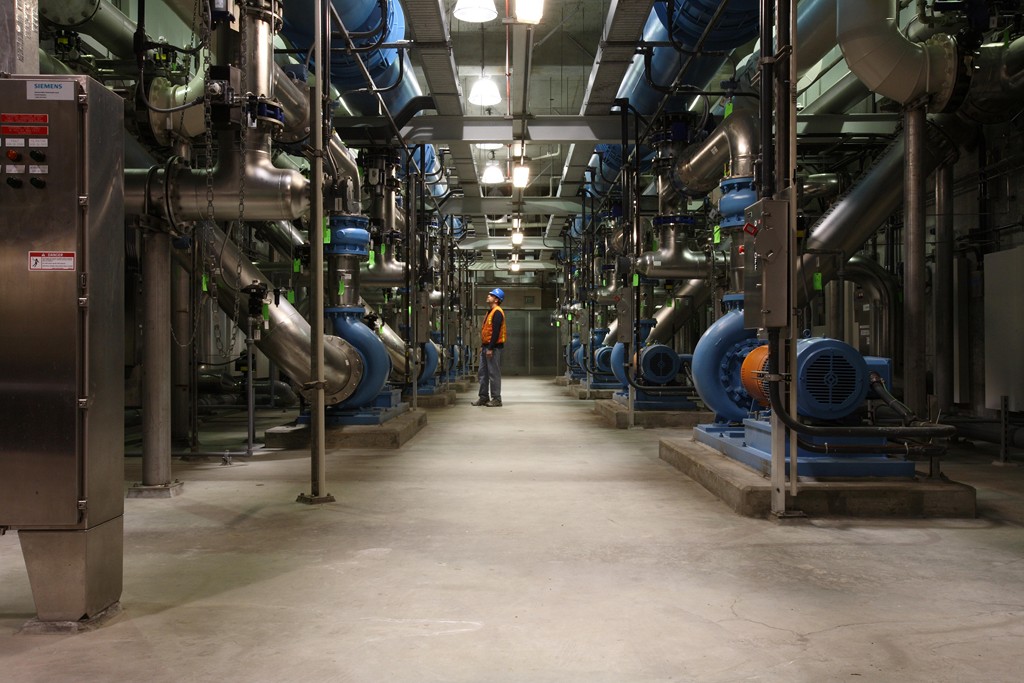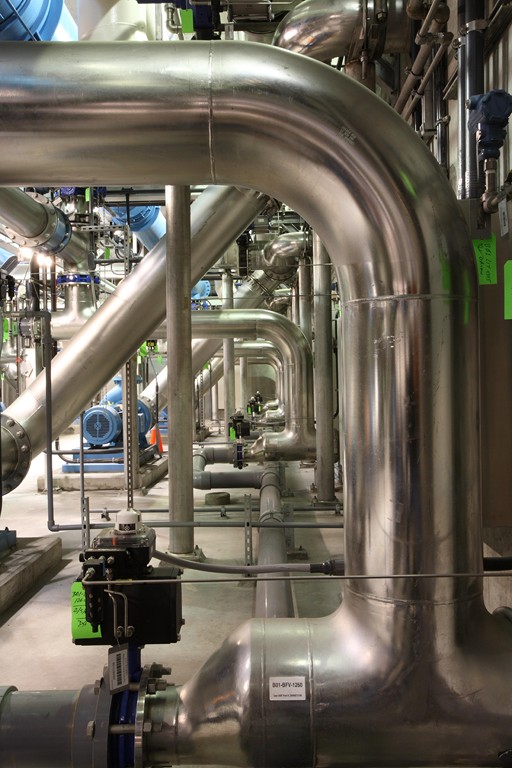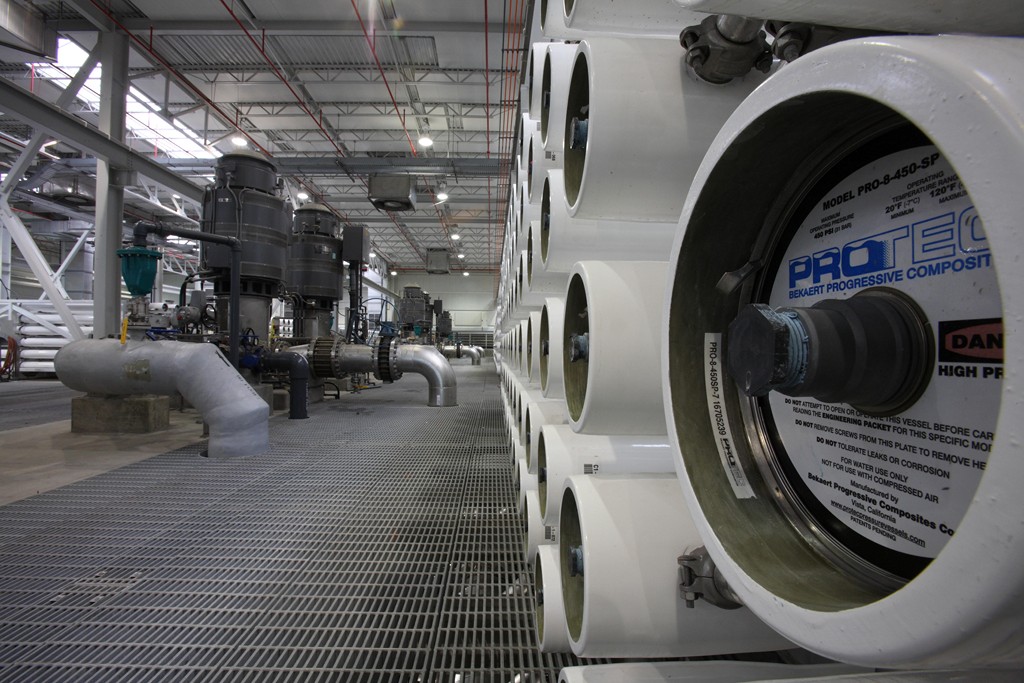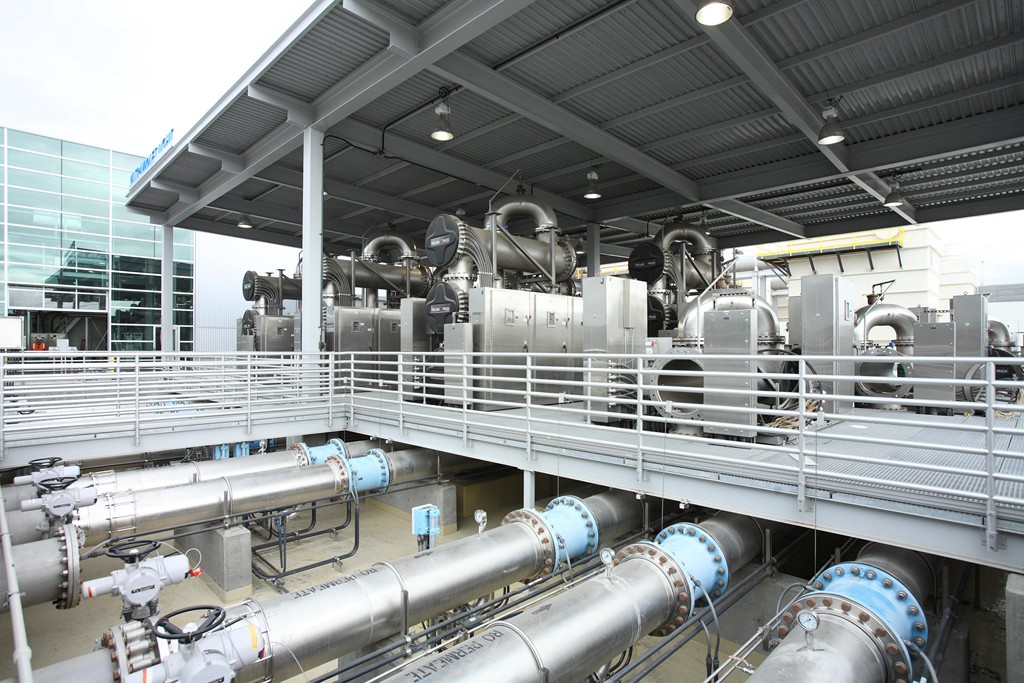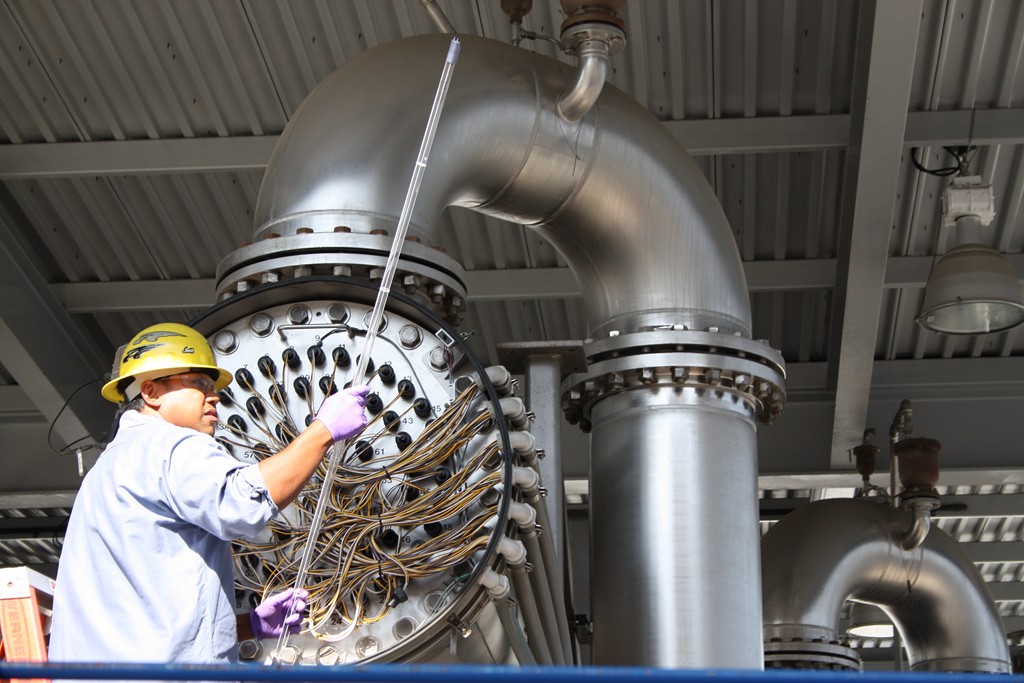Refreshing the Supply

In January 2008, southern California’s Orange County Water District unveiled its Groundwater Replenishment System, a treatment and reuse facility dedicated to producing water to resupply the county’s beleaguered groundwater reserves. A year later, Eric Herman toured the facility, getting a behind-the-scenes look at a thought-provoking system that is setting new standards for water treatment, management and use.
While I was preparing our “True Green” issue for publication last summer, a friend invited me to tour the Groundwater Replenishment System, an advanced, 70-million-gallon-per-day water-purification facility located in Fountain Valley, Calif. The invitation to visit this joint project of the Orange County Water District and the Orange County Sanitation District came through landscape designer Brian Dong, whose college friend Tom Knoell conducts sophisticated studies of the various water-treatment processes used in the system.
At the time, my experience with our special October 2009 issue was sparking all sorts of thoughts in me about the preciousness of water as a resource. When the invitation came, I realized that all of us in the watershaping realm might benefit from understanding what’s happening with the water supply and the steps being taken to ensure its availability into the future.
Before I reached the facility, of course, I already knew that water was a precious commodity. Once the tour was complete, however, I had a new appreciation for the monumental stature of the challenges we all face as a species dependent on abundant supplies of fresh, potable water – and became especially concerned for people who make their livings by shaping water.
STORIED BACKGROUND
As Knoell treated us to our tour, his enthusiasm for his work was obvious. It was clear that being part of developing and fine-tuning the largest and most advanced system of its kind was a source of professional pride. Furthermore, I perceived a sincere (and infectious) environmental idealism that would inspire anyone who consumes water or uses it for artistic or commercial purposes.
As we talked, it occurred to me that it made sense for Orange County to be on the cutting edge with this technology: It’s been one of the country’s fastest growing jurisdictions for more than 50 years, is now home to more than 3.2 million people and is expected to see that level increase by 20 percent between now and 2020. And this growth will come on top of established water needs for public irrigation, industry and agriculture.
A complicating factor is that this is an area subject to extended drought conditions, which means that ensuring an adequate water supply always requires planning, huge investments in infrastructure and tremendous levels of ingenuity.
Historically, the region has relied in part on water imported from the Colorado River and from northern California – as is true of much of southern California. Securing those water allocations is becoming both harder and more expensive, placing a greater premium on self-reliance and exploitation of local resources. In Orange County, that has long meant exploiting groundwater resources, a consumption that leads to obvious concern about how the supply is protected and maintained.
| The scale of the Groundwater Replenishment System is truly grand, with each of the three treatment steps housed in its own facility and accompanied by pumping facilities, research laboratories – and an operating center so streamlined and automated that the entire process is managed by a staff of four. (Photo at right by Larny Mack, courtesy of CDM) |
Orange County was once mainly a thriving agricultural region and had been sustained by the use of groundwater for more than 200 years. Consumption of this resource has spiked in the past 50 years, as the population grew and industrial operations displaced farmland and pastures.
As Knoell explains, when water is pumped out of the ground, it leaves behind voids. In the case of coastal Orange County, this allowed for the intrusion of seawater into the groundwater supply, rendering huge volumes of water unsuitable for drinking. Adding to the problem, the region contains considerable petroleum deposits. As those resources have been extracted through the years, the voids left behind have also encouraged seawater migration.
The consequences of this seawater intrusion prompted the Orange County Water District (OCWD) to overcome the problem by injecting highly purified wastewater in the ground along the coast. The success of this effort led to continued injection and eventually will lead to effective recharging of the groundwater supply using water provided by the Groundwater Replenishment (GWR) System.
The 70 million gallons the GWR System generates daily, Knoell says, serve multiple purposes: producing an expanded barrier to seawater intrusion; increasing the amount of water available for public use; buffering shortages in times of drought; reducing reliance on the Colorado River and northern California supplies; and ultimately reducing the amount of treated sewage dumped into the ocean.
TACKLING THE PROBLEM
In 1975, the district opened the now-famous Water Factory 21, an innovative system that purified treated sewer water from the Orange County Sanitation District (OCSD). This pioneering facility was the first to treat wastewater with reverse osmosis before it was pumped back into the ground through a system of injection wells along the coast as a means of slowing the infiltration of seawater into the groundwater supply.
Before long, Water Factory 21 was producing 15 million gallons of water per day and was so successful that it became a model for a whole generation of similar facilities throughout the United States and abroad – a real solution for jurisdictions facing similar problems with seawater intrusion.
As Knoell explains it, the concept is simple: OCWD took treated water coming out of an OCSD facility and, instead of allowing it to flow into the ocean, treated it to better-than-drinking-water standards using advanced membrane-filtration processes. The water would then be injected into the ground to maintain a barrier to prevent seawater intrusion.
(In the case of the recently commissioned GWR System, the capacity is such that half of the highly treated water is piped 13 miles inland to spreading basins located in the cities of Anaheim and Orange. There, the water is naturally purified through percolation into the aquifer. The groundwater is eventually available for extraction in residential, commercial and agricultural applications. In that sense, he says, the new system indirectly provides the county with a portion of its potable water.)
| The microfiltration stage of the treatment process occurs in a cluster of 26 open cells containing more than 600 separate filters. These cells are challenged by so much material that each one is taken offline every 21 minutes for a brief backwashing operation. The water that emerges at the end of the process is much cleaner – but still not drinkable. (Photos here and at the top of the article by Steve Crise, courtesy American Water Works Association) |
Using the resounding success of Water Factory 21 as a foundation, OCWD moved toward expanding on the concept. In 2002, it released a crucial White Paper outlining the scope of the propose GWR System and began accumulating funds from a variety of sources – federal, state, local and private – up to $92 million of the ultimate $480 million cost. (As proposed and realized, the facility is a joint financial venture between OCSD and OCWD, with the water district taking responsibility for its operation and maintenance.)
The water entering the new facility comes straight from OCSD as “secondary effluent” – meaning the wastewater has already passed through a primary treatment step in which clarifiers and sedimentation basins settle the sludge and a secondary treatment in which biological processes degrade the biological and organic material still found in the water.
This water, says Knoell, is relatively biostable at this point: It still contains a host of bacteria, organics and inorganic material when it enters the GWR System, but by the time the water leaves, it meets or exceeds drinking-water standards. As he put it, the output is near distilled-water quality – so much so that minerals must be added back to the water at the end of the process.
CLINICAL PRECISION
The processes used first at water Factory 21 and subsequently in the GWR System were developed, in fact, using methods similar to those used in treating bottled water or water for use in preparation of baby food, fruit juices and sodas – and to sterilize medicines. The GWR System uses a three-stage process of microfiltration, reverse osmosis and, finally, a combined treatment with hydrogen peroxide and ultraviolet light.
The system is fully automated – so much so that operation of the facility can be accomplished by just four people. Beyond that, of course, the facility employs a large staff that supports the project in a variety of capacities. Knoell, for instance, heads up activities at the GWR System’s test center, a facility dedicated solely to conducting applied research aimed at optimizing the processes used in the treatment system. (During our visit, for example, he was in the midst of conducting trials on a new filter material being considered for use in the microfiltration process.)
He explained to us that the technologies used in the GWR System have a huge range of other applications in everything from food processing and pharmaceutical manufacturing to treating the water in swimming pools. What makes the GWR System so special, he says, is the monumental scale of the facility and the combination of technologies it puts to use. Among other things, his studies have led to a planned expansion of the system that will take its capacity to 100 million gallons per day.
A combination of three treatment processes makes up the GWR System:
[ ] Microfiltration: When water first reaches the facility, it’s treated with a chemical familiar to many watershapers – sodium hypochlorite (that is, bleach) – at a level of three to four parts per million. As with swimming pools, the sole purpose of introducing bleach is to reduce the biological activity as the water moves through the system. The water then enters the microfiltration process.
The microfiltration operation features 26 cells (or basins) that contain more than 600 separate filters (or modules) in each cell. In turn, each of these modules contains more than 15,000 hollow polypropylene fibers with holes that that are 0.2 microns – one -three-hundredths the diameter of a human hair and small enough to allow water molecules to pass through while removing larger molecular structures such as bacteria, protozoa and viruses. At the current full plant production capacity of 70 million gallons per day, the microfiltration process receives approximately 96 million gallons of water per day, with the difference being attributable to the fact that the microfiltration process has an overall recovery rate of 90 percent.
As the microfiltration cells operate, debris and other contaminants are filtered out and onto the module fibers and eventually block the flow of water. To combat this, each cell is taken out of service for a few seconds approximately every 21 minutes for backwashing. In this process, the fibers are scoured by air and then backwashed with water that has already been through the microfiltration process; this backwash water is sent to waste.
As time passes, backwashing becomes ineffective as material builds up on the fiber surfaces. As a result, the microfiltration cells are taken off line every three weeks and chemically cleaned using caustic sodium hydroxide, a proprietary cleaner and citric acid.
When water emerges from this stage of the process, it is virtually free of bacteria, but still contains a wide range of organic and inorganic contaminants. The water, in other words, is much cleaner but is not yet drinkable.
Before it passes to the next step and into the reverse-osmosis process, the water is chemically treated with sulfuric acid to reduce its pH from 7.5 to 6.8. Another chemical is added as well to prevent salts from precipitating onto the membranes as the water passes through the reverse-osmosis process. Now the water enters banks of cartridge filters to ensure that any debris that might be lurking in the process stream is removed before the water enters the high-pressure feed pumps and encounters the reverse-osmosis membranes.
[ ] Reverse Osmosis: Reverse osmosis is a filtration process that can remove particles down to an estimated 0.0001 microns – a level so small that some experts refer to it as “theoretical zero.”
| Reverse osmosis is the workhorse of the purification process, with its 15,750 membrane units (each with 400 square feet of a special filtering medium) removing all remaining contaminants and bringing 85 percent of the water that enters the system up to extremely high levels of purity. (Photos by Steve Crise) |
This process removes viruses, inorganics and almost everything that isn’t water from the flow. (As Knoell states, it’s the workhorse of the GWR System and where the bulk of the filtration occurs.) In the GWR System, the reverse-osmosis array consists of 15 units, each with a capacity of five million gallons per day. Within each unit are 1,050 membranes – a total of 15,750 in all. On any given day, one unit is held out of the stream as a spare.
As with the microfiltration process, not all of the water entering the system is recovered. In this case, 85 percent of the water entering the RO system is actually transformed into pure water, leaving 15 percent of what is called “reject water” to be returned to OCSD. This means that, to meet the 70-million-gallon-per-day target, the microfiltration process must produce approximately 82 million gallons of feed water each day for feeding into the reverse-osmosis process.
Each of the reverse-osmosis filters contains 400 square feet of a polyamide membrane. As Knoell explains, it was the advent of this material that allowed this technology to become economically feasible on a large scale. Before polyamide came along, membranes were constructed of cellulose acetate and required much more pressure and power consumption to purify the water. Not only does the polyamide material function at lower pressure and require less power, but it also produces water of far superior quality.
The water goes through a three-stage, single-pass structure of reverse osmosis membranes – 78 in the first stage, 48 in the second and 24 in the third – with an overall recovery of 85 percent of the water. The remaining reverse osmosis brine (or concentrated mineral water) is returned to OCSD and disposed of through ocean outfall.
[ ] Hydrogen peroxide/ultraviolet light treatment: After leaving the reverse osmosis facility, the water moves to a final treatment stage – ultraviolet disinfection coupled with hydrogen peroxide – in a process called “advanced oxidation.” Here, water is injected with a small concentration of hydrogen peroxide and then passed through a series of reactors that expose the water to low-pressure, high-intensity ultraviolet lamps. This process, says Knoell, is designed as a multiple-barrier system to safeguard against any off-chance, trace organics that may have evaded the previous treatments.
| As a third and final step, the water is injected with hydrogen peroxide and passed through a bank including 4,000 high-intensity, 250-watt ultraviolet lamps. After this step, the water is of amazing purity – well beyond drinking-water standards and ready for injection along the coast to prevent seawater intrusion into the groundwater supply. (Photo at left by Steve Crise) |
As the treated water passes through this advanced-oxidation process, the ultraviolet light transforms a portion of the hydrogen peroxide into hydroxyl radicals that act as extremely powerful (but short-lived) oxidizing agents. After that, the water is ultra-pure and, as Knoell says, may well be the highest-quality water that can be produced using currently available technologies.
ON FURTHER REFLECTION
Once the tour ended, my head filled with questions about how all of this information applied to the working lives of people who build swimming pools, fountains, ponds, streams and other watershapes, not to mention those who design and install landscapes.
Obviously, professionals whose livelihoods depend to an unimaginable degree on the continuing availability of public water should know a thing or three about where that water comes from. Beyond that – and in the context of the package of “True Green” articles I was then compiling – I quickly began connecting the dots and recognizing just how well positioned watershape and landscape designers and builders are when it comes to working with a whole range of systems that can maximize efficient use of water.
| As much as half the output of the Groundwater Replenishment System is pumped 13 miles away from the facility to fill spreading basins from which the water percolates into the soil and ultimately replenishes Orange County’s supply of drinking water. In this form, the waters are stocked with fish and serve a variety of recreational purposes – a new and unusual form of watershape designed to serve the long-term needs of the county and its burgeoning population. (Photos by Mark Greening, courtesy Orange County Water District) |
There are the obvious ones, including the installation of rainwater harvesting systems, the assembly of constructed wetlands, the placement of floating islands and inclusion of systems that put gray water to use – to mention just a few. Indeed, what I began to see was that even modest residential projects could do more to mimic what Orange County’s Groundwater Replenishment System does by engaging every possible means of returning clean water to the groundwater system by letting it percolate into the soil instead of letting it flow to waste.
Obviously, there are issues of scale that must be recognized, but really, all Orange County’s system does is take water that would otherwise flow to waste, treat it and then put it to good use – in this case by putting it back in the ground. And it’s also being done with a smaller carbon footprint and costs less than ocean desalinization. Yes, this system cost half a billion dollars, but fractional versions could do the same work at a fractional cost.
I was struck as well by the fact that Knoell described his facility as a demonstration site and stressed the fact that the GWR System operates on principles of conservation and sound environmental management that can be applied (and are being applied) on much smaller scales in other applications. To be sure, it will be a while before these systems are ready to be strapped onto portable spas, but they’ll be with us soon enough – whether by choice or by mandate.
Moreover, people are taking notice of what’s happening here: In the two years since the GWR System came online, it has received an array of international engineering and environmental awards as well as lots of media attention. And in just its first year, more than 4,000 toured of the facility, including scores of high school and college students with a clear interest in water management and technology.
Having been through the facility myself, I know these young visitors are showing up and asking questions for good reason: Not only does this system represent a magnificent technical achievement, but it’s also a facility that is crucial to sustaining the quality of their lives and protecting the environment in which they and their children will live.
One last thought: You remember those spreading basins the water district operates about 13 miles away from the main facility in Fountain Valley? It bears mentioning that it’s a grand series of watershapes in the form of well-maintained, landscaped public lakes used for fishing and recreation.
Eric Herman is editor of WaterShapes. A career writer and editor with more than 25 years’ experience, he has published and edited articles for publications across a wide range of industries, technical subjects and cultural interests. A native of southern California, he graduated from California State University at Fullerton in 1983 with degrees in Journalism and English literature. In addition to his work in magazines, he has published poetry and written screenplays, technical manuals and speeches and is an aspiring novelist. Herman has worked for McCloskey Communications since 1996 and was the founding editor of WaterShapes in 1999.










